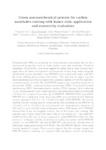Please use this identifier to cite or link to this item:
http://www.alice.cnptia.embrapa.br/alice/handle/doc/1068138| Title: | Green mecanochemical process for carbon nanotubes coating with humic acid: application and ecotoxicity evaluation. |
| Authors: | COA, F.  CLEMENTE, Z.   LOPES, J. R.   RODRIGUES NETO, L. L.   ALVES, O. L.   CASTRO, V. L. S. S. de   BARBIERI, E.   MARTINEZ, D. S. T.   |
| Affiliation: | F. COA, CNPEM; Z. CLEMENTE, Bolsista; J. R. LOPES, CNPEM; L. L. RODRIGUES NETO, Unicamp; O. L. ALVES, Unicamp; VERA LUCIA SCHERHOLZ S DE CASTRO, CNPMA; E. BARBIERI, Instituto de Pesca; D. S. T. MARTINEZ, CNPEM. |
| Date Issued: | 2016 |
| Citation: | In: ENCONTRO ANUAL DA SOCIEDADE BRASILEIRA DE PESQUISA EM MATERIAIS, 15., 2016, Campinas. [Abstracts...] Rio de Janeiro: Sociedade Brasileira de Pesquisas em Materiais, 2016. Resumo B6SZ. |
| Description: | Nanomaterials (NM) are promising for environmental remediation due to their unreleased properties such as high surface area and reactivity. Chemical oxidations (H2SO4/HNO3) have been applied to carbon NM in order to favor their application, but these are expensive and hazardous. In this work, industrial grade multiwalled carbon nanotubes (raw-MWCNT) were coated with humic acid (HA) by a ball milling processing (solid state). The aim was to apply a green mechanochemical process to improve the colloidal stability of MWCNTs and their removal capacity of metals. The HA-MWCNT complex was studied by atomic force microscope (AFM), scanning electron microscope (SEM), X-ray photoelectron spectroscopy (XPS), thermogravimetric analysis (TGA), dynamic light scattering (DLS), electrophoretic light scattering (ELS) and ultraviolet-visible spectroscopy (UV-Vis). Cu2+ sorption from water by HA-MWCNT, MWCNT-COOH and milledMWCNT were compared. Acute bioassays (96h) were performed with Daphnia magna exposed to 0.0; 0.1; 1.0; 5.0 and 10.0 mg/L of HA-MWCNT. Our results showed that the coating process enhanced the zeta potential of raw-MWCNT of -25.4±0.2 mV to -37.4±0.7 mV and reduced their hydrodynamic diameter of 393.2±27.3 nm to 212.5±5.6 nm in ultrapure water. AFM images of HA-MWCNT showed that it has an irregular surface, due to the humic acid coating. The complex was 4 times (84±1.8%) more efficient to remove Cu2+ than MWCNTCOOH (20.0±1.4%) and 11 times compared to milled-MWCNT (7.6±3.1%). The increases in Oxygen and the reductions in Carbon on surface of HA-MWCNT relative to raw-MWCNT and milled-MWCNT indicated the introduction of functional oxygenated groups on MWCNT. The HA-MWCNT did not show acute toxicity against D. magna. These results suggest that the coating changes the MWCNT surface, resulting in a material with potential to metal remediation, prepared without oxidizing acids and that did not show toxicity on D. magna. |
| Keywords: | Ecotoxicologia Nantubes |
| Type of Material: | Resumo em anais e proceedings |
| Access: | openAccess |
| Appears in Collections: | Resumo em anais de congresso (CNPMA)  |
Files in This Item:
| File | Description | Size | Format | |
|---|---|---|---|---|
| 2016RA040.pdf | 50.59 kB | Adobe PDF |  View/Open |









